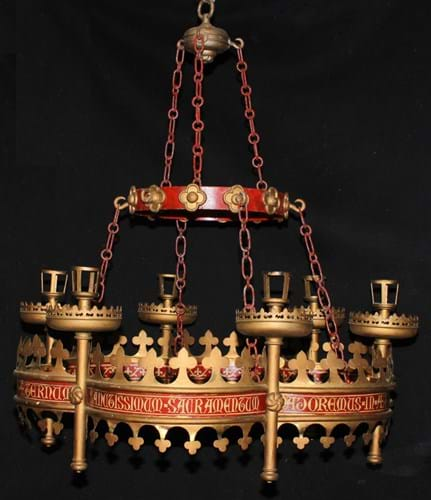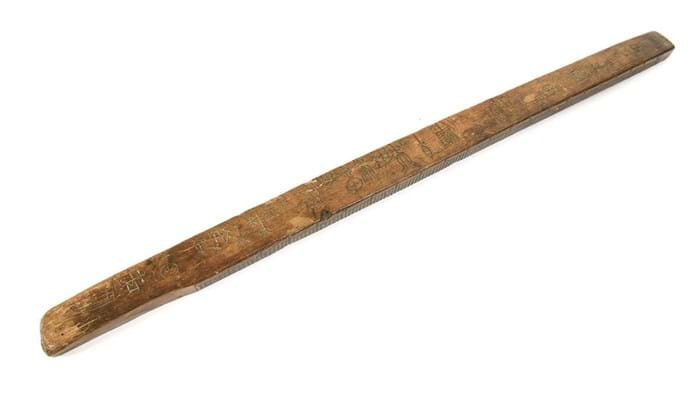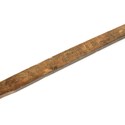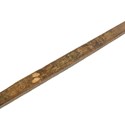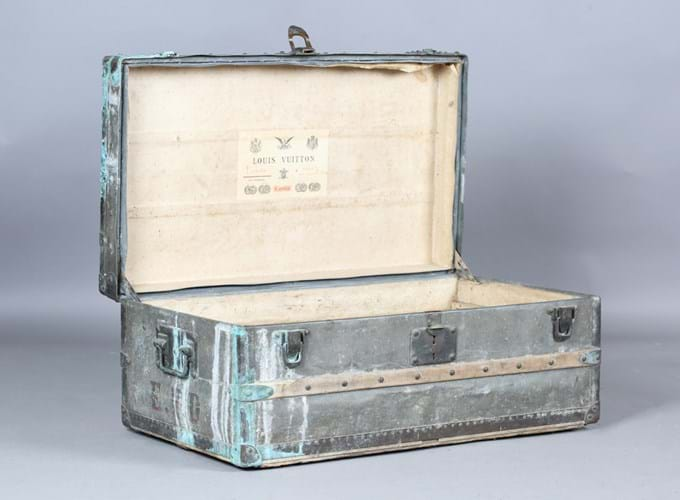
The late 19th century Louis Vuitton zinc Explorer trunk sold for £66,000 at Toovey’s in Washington, West Sussex.
1. Louis Vuitton Explorer trunk – £66,000
Late 19th century Louis Vuitton Explorer trunks are a rare and desirable subset of vintage luggage.
Made in zinc, copper, brass or aluminium, the flat-topped ‘malle cabine’ was designed to meet the requirements of intrepid European travellers to tropical climes. Easily stacked, the hardwearing, air-tight form was invaluable for keeping the contents free from water, insects and dust. Most survivors date from c.1890-95. Those found in the UK – and there have been half a dozen zinc examples sold at auction in the past decade – often carry a paper manufacturer’s label inside with Louis Vuitton’s former Oxford Street address (opening in 1885) erased and changed to 454 Strand where the firm moved in 1888. The company’s signature ‘monogram’ canvas was not launched until almost a decade later.
Toovey’s in Washington, West Sussex is now a seasoned hand in selling zinc Explorers. They offered one in October 2017 (£26,000), followed by another that made £30,500 in December 2019. Others have sold at Guernsey’s Martel Maides in June 2019 (£29,000) and at Thimbleby & Shorland in Reading in November 2019 (£27,000).
Toovey’s found a third for its sale on January 19. All Louis Vuitton trunks are numbered with this one, measuring 2ft 8in (81cm) across, inscribed 37942. According to family history, the inscribed name Dickin and initials EPD to the top and sides are believed to relate to Dr Edward Percival Dickin. Born in Yorkshire in 1871, he studied in Paris and worked in Northampton Hospital.
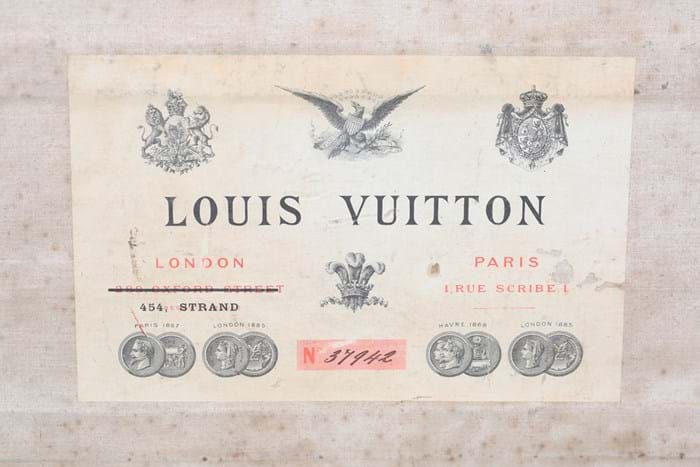
The trunk carries a paper manufacturer’s label inside with Louis Vuitton’s former Oxford Street address (opening in 1885) erased and changed to 454 Strand where the firm moved in 1888.
In fine original condition, although showing some verdigris to the brass mounts and oxidisation to the iron casters, it went well past its £20,000-30,000 estimate to sell for £66,000. Toovey’s believes it is a record for this type and one of the highest sums ever paid for an LV trunk at auction.
The rarest of all Vuitton Explorer trunks is the aluminium model. Just a handful of these were made in a single year (1892) at a time when aluminium was considered a precious metal. Christie’s sold one in December 2018 for £130,000 (plus 25% premium), with the other known example in the Louis Vuitton Foundation in Paris.
2. Ecclesiastic chandelier by Pugin – £12,500
This Victorian brass and iron ecclesiastic chandelier or corona lucis is by Augustus Welby Northmore Pugin (1812-52) – the most famous name in the Gothic Revival. Almost certainly made by John Hardman and Co, the Birmingham metalworking firm that produced most of Pugin’s furnishings and decorations, it is painted in red and gold with the inscription Adoremus in Aeternum Sanctissimum Sacramentum (Let us adore unto eternity the most holy sacrament).
The 3ft 2in (95cm) diameter chandelier was removed in the 1930s from St Giles Roman Catholic Church in Cheadle, one of more than 100 Anglican and Catholic buildings designed by Pugin as part of the great awakening of the early 19th century but also one of the most compete. At St Giles – known locally as Pugin's Gem – he was responsible for all aspects of the building, fittings and decoration completed between 1841-46.
Offered for sale at Bamfords in Derby on January 19-23 with a guide of £6000-8000, it took £12,500.
3. Scandinavian calendar stick – £2400 at Tennants
Among the best performing lots at the Country House sale at Tennants in Leyburn on January 13-15 was a fruitwood calendar stick or primstav.
Perpetual calendars such as this were in common use in Scandinavia into the 18th century, marking the yearly rhythm of agrarian societies in the northernly latitudes. The name comes from prim, the old Norse word for the new moon.
Traditionally made of a stick of wood, they were marked on each side for the two Nordic seasons – a summer side and a winter side – with divisions for each day and symbols for religious holidays, equinoxes and festivals. Primstav only fell from fashion with the move to a Gregorian calendar and the advent of affordable printed or mechanical devices for predicting seasonal shifts and the weather.
This example, a nice example of treen as well as an object of social history, was thought to date from the 18th century. A rectangular section staff, measuring 2ft 11in (27cm), it was carved with typical markings and to one side with the Nordic surname Kolben.
Estimated at £150-200, it took £2400.
4. Shang oracle bone – £5000
The Shang period (c.1600-1045 BC) is the first of China’s many epochs from which written documents survive. Some inscriptions – the root of modern Chinese writing- are found on bronzes of the period, but most take the form of inscribed bone fragments used for divination.
Oracle bones or jiaguwen, fashioned from carefully prepared turtle plastron or water buffalo bone, were used in divination ceremonies to seek guidance from deities or ancestors on topics ranging from military strategy and the harvest to the cause of toothache.
When first found in an archaeological context in the early 20th century, they confirmed the site of the last Shang capital city of Yinxu, near modern-day Anya, revealed a mature writing system using grammar and over 5000 different characters, and shed light on a once commonplace ritual activity.
Captain James Mellon Menzies (1885-1957), a Canadian Presbyterian missionary and archaeologist was the first Western scholar to study Shang bone script. His book Oracle Records from the Waste of Yin was first published in 1917 at a time when hoards of jiaguwen turned up by the plough were being sold by local farmers as ‘dragon bones’ for use in traditional medicine.
Jiaguwen don’t come to the market very often. The example offered at Galerie Zacke in Vienna on January 18 came for sale from the estate of Paolo Bertuzzi (1943-2022), an engineer and fashion stylist from Bologna who was an avid collector of antiques for more than 60 years.
His jiaguwen was a well-preserved 5.5in (14cm) turtle plastron with an array of engraved inscriptions arranged in orderly rows. Similar to another in the Taipei Museum collection, it was estimated at €250-500 but sold at €5500 (£5000).
5. Abdul Rahman letter – £7000
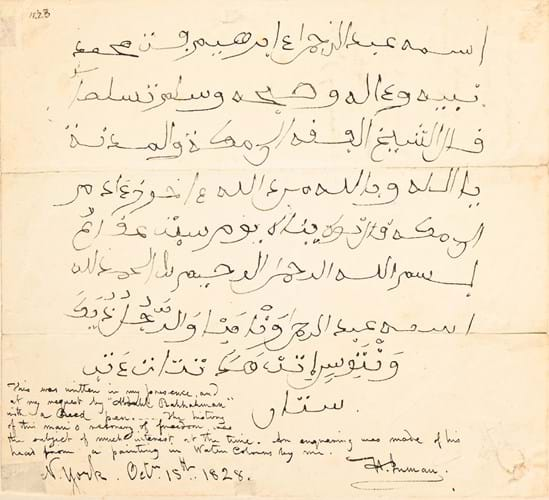
A note written to the artist Henry Inman by Abdul Rahman Ibrahima Sori shortly after he was freed from slavery, £7000 at Mellors & Kirk.
This single page letter, offered for sale on January 19 by Mellors & Kirk, tells the remarkable story of Abdul Rahman Ibrahima Sori (1762-1829).
A prince and military commander born in Timbuktu, he was captured and sold into slavery in 1787. He endured almost 40 years of hard labour in Mississippi before he was finally gained his freedom in 1826.
Before he travelled back to Africa in 1828, Abdul Rahman was granted an audience with John Quincy Adams and raised $4000 during a 10-month tour of various northern cities to be used to free his family in Natchez. He also sat for his portrait in New York, the artist Henry Inman (1801-46) painting him in the Moorish dress he often favoured in the hope of distinguishing himself from other black African slaves.
It was during the sitting that this note was written. The nine lines of calligraphic script in praise of Allah were penned by Abdul Rahman with Inman adding some commentary below: ‘This was written in my presence, and at my request by Abduhl Rahhaman [sic] with a reed pen. The history of this man's recovery of freedom was the subject of much interest at the time. An engraving was made of his head from a painting in Water Colours by me, H Inman, N York, October 15th 1828.’
According to an inscription verso it was later given by Inman to a friend R Gilmor Esq in 1833 and it came for sale in Nottingham with a provenance to Dr Frank Lester Pleadwell (1872-1957), a physician and bibliophile.
It was estimated at £300-500 but such an emotive example of black Americana brought £7000 from an online bidder using thesaleroom.com.


